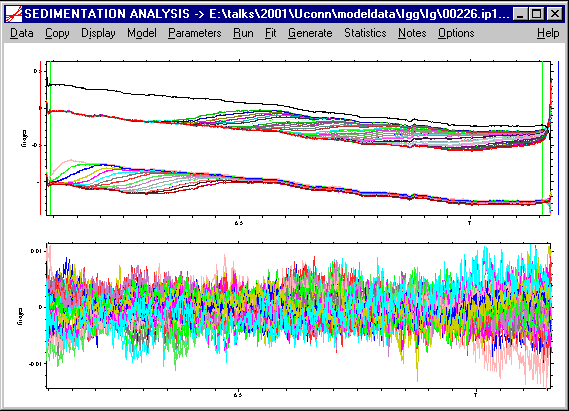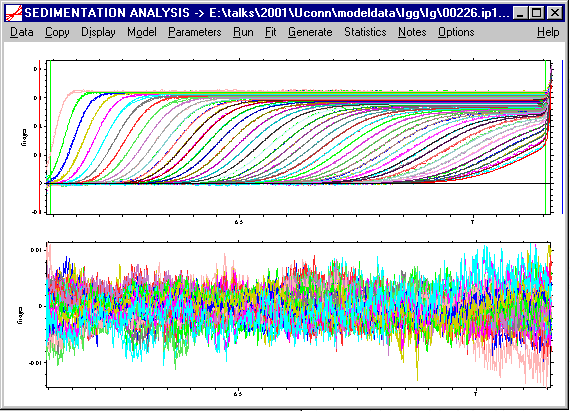
Subtract Calculated Systematic Noise From Raw Data
Display | subtract calculated TI noise from raw data
Display | subtract calculated RI noise from raw data
Display | subtract all systematic noise from raw data
(keyboard shortcut ctrl-N)Display | restore original TI noise to data
Following the concept of direct boundary modeling to fit directly the raw data, all systematic noise components are included into the model (see the page on systematic noise analysis, and the fit TI Noise and fit RI Noise fields in the parameter box). Therefore, no corrections of the data for any integral fringe shifts, vertical displacement of the scans (jitter), or time-invariant noise are needed.
However, it can be very useful to subtract the best-fit estimates of the systematic noise components from the data, in order to visualize the sedimentation boundary more clearly. This can be achieved using the above functions in the display menu, either for the TI or RI noise separately, or for both together.
It should be noted that this does not change the information content of the data, nor does it increase the statistical noise. Because the instrumental imperfections cause some arbitrary systematic offset to the 'true' sedimentation profiles, we can add another arbitrary offset (with the same degrees of freedom) without changing any information. In the process, we can try to cancel the instrumental offsets by using our best-fit estimates of these offsets. It is important, however, not to switch off the systematic noise fitting afterwards, because this would eliminate the corresponding degrees of freedom, and introduce bias. If we keep these degrees of freedom, there is no bias introduced. Also, it should be noted that the graphical estimation of the meniscus position is not possible after the systematic noise subtraction.
Sometimes it may be useful to inspect the original TI noise that was contained in the raw data. SEDFIT keeps track of it, and using the function "restore original TI noise to data", one can go back to the original TI noise.
This is an example: First, we fit directly the raw data, inclusive the obvious integral fringe shifts, the jitter, and the obvious time-invariant noise.
! [Although we could in principle try to correct for some of the jitter and integral fringe shift, similar as this is being done for the dcdt sedimentation analysis (see loading options eliminate interference offset and eliminate jitter), this is not necessary in SEDFIT and included for methodological comparison only]

If the fit is satisfactory, we can expect a realistic estimate of the systematic noise offset. In the example, the upper black line indicates the best-fit TI noise profile. We can subtract this offset, as well as the vertical displacements (RI noise) by using the function "subtract all noise from raw data" (either using the mouse and clicking at the menu function, or by using the keyboard shortcut ctrl-N). This causes the following message box to appear,

as a reminder that one should not switch off any of the systematic noise calculations. As a result, the sedimentation boundaries appear very clear now, and can be visually inspected for details.
